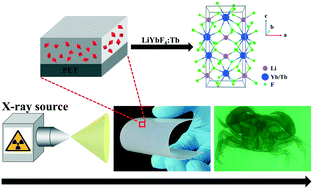Terbium-doped LiYbF4 nanomaterial-based scintillator responding to X-rays with high-resolution imaging applications†
Abstract
Scintillators can convert high-energy rays into ultraviolet or visible light and are widely used in medical diagnosis, safety inspection, and industrial flaw detection. Nowadays, conventional scintillation materials have certain limitations, including the extreme synthesis conditions and complex synthesis process of bulk scintillators, as well as toxicity and poor stability of perovskite quantum dots (QDs). Fluoride has high stability and simple synthesis, which can effectively solve these problems. LiYbF4 has the advantages of a larger atomic number and density, and the synthesis of LiYbF4:Tb nanocrystals (NCs) exhibited good stability to thermal injection. X-ray tests showed that Tb3+-doped LiYbF4 NCs were more sensitive to X-rays than the commercial scintillator BGO, and the detection limit was 360 nGy s−1, which was 1/15 of the medical X-ray detection dose rate. Our self-made scintillation film with a load of 40 wt% and a thickness of 150 μm had excellent X-ray imaging capabilities with a spatial resolution of up to 20 LP mm−1 (MTF = 0.35), which shows great application potential in the X-ray imaging of biological and non-biological structures.



 Please wait while we load your content...
Please wait while we load your content...